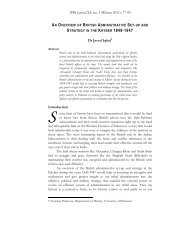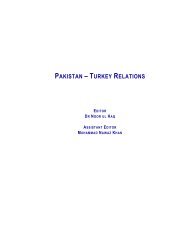120 Whither Kashmir? (Part II) - Islamabad Policy Research Institute
120 Whither Kashmir? (Part II) - Islamabad Policy Research Institute
120 Whither Kashmir? (Part II) - Islamabad Policy Research Institute
Create successful ePaper yourself
Turn your PDF publications into a flip-book with our unique Google optimized e-Paper software.
56 IPRI Factfile<br />
expenditures to the level that your enemy breaks down if it tries to<br />
compete, India, by military expansion, is forcing Pakistan to follow suit<br />
and economically get destroyed.<br />
Pakistan, with a regressing economy, cannot keep up with Indian<br />
defence outlays even on proportional basis. Therefore, Pakistan has no<br />
choice but to detract and pull India back through other means. Pakistan’s<br />
strategy has not worked very well because, despite the <strong>Kashmir</strong> issue,<br />
India has grown steadily. Probably, Pakistan’s military leadership is<br />
aware of its unsuccessful strategy and, therefore, trying to strengthen the<br />
state institutions to match Indian economic growth. However, it cannot<br />
let go of instruments developed to keep India distracted.<br />
Besides the real geographic and economic issues between India and<br />
Pakistan, the public opinion in both countries has hardened. The new<br />
electronic media, run by not-so-well-groomed people, looks for the easy<br />
formula to dub villains in a situation. The Indian media quickly blames<br />
Pakistan for any bomb blast in their country and the Pakistani media<br />
reflexively traces the tragic incidents on its territory to an Indian<br />
conspiracy. The situation has become so messy that it is hard to tell who<br />
is doing what.<br />
The public in both countries accept the media versions because of<br />
changing public psyche due to internal conflicts and extreme rightwing<br />
forces donning the mantle of patriotism. While Pakistan is fighting the<br />
Taliban and other jihadi outfits, India is also mired in communal, ethnic<br />
and guerrilla insurgency. The Gujarat massacre of Muslims, the Shiv Sena<br />
crusade to cleanse Maharashtra and Mumbai of North Indians, and the<br />
Maoist guerrilla war are just a few things that have embittered the public<br />
psyche. A psyche born out of a constant conflict-ridden atmosphere can<br />
easily be turned against other nations.<br />
The right wing’s monopoly over patriotism in Pakistan, a wellentrenched<br />
phenomenon, has been replicated in India. The rise of the<br />
Bharatiya Janata <strong>Part</strong>y (BJP), especially the Narendra Modi brand, and<br />
the likes of Bal Keshav Thackeray, founder of Shive Sena, have become<br />
the standard bearers of national pride. They have pushed the Congress<br />
<strong>Part</strong>y to the right as well in pursuit of patriotism. The decline of<br />
communist parties in North India has also been responsible for the<br />
unchecked rise of a jingoistic style of nationalism. The dynamics of<br />
generating hatred are becoming much more powerful than the forces<br />
preaching reconciliation within the country and in the international<br />
arena.




